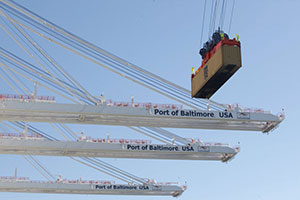Trade Gap Narrows as Imports Fall

The trade deficit in the U.S. narrowed more than forecast in April as imports receded, signaling merchandise flows were returning to normal after a port-related surge.
The gap shrank by 19.2% to $40.9 billion from the prior month’s $50.6 billion that was the widest in more than six years, Commerce Department figures showed June 3.
The median forecast in a Bloomberg News survey of 72 economists called for a deficit of $44 billion. Purchases of foreign-made goods declined after the end of a labor dispute at West Coast ports caused them to jump in March.
Trade may become less of a detriment to the world’s largest economy as a more stable dollar and strengthening markets in Europe underpin overseas demand for American-made goods. At the same time, crude-oil production probably will continue to limit imports after the U.S. petroleum gap fell in April to the lowest level in 13 years.
“The trade gap returned to more normal levels after an inordinately large increase,” said Guy LeBas, chief fixed-income strategist at Janney Montgomery Scott in Philadelphia, who projected the deficit would shrink to $39.5 billion. “That starts off the second quarter on a reasonably positive note.”
Companies added more workers in May than the prior month, a sign U.S. job growth is getting back on track after a slow start to the year, another report showed June 3. The 201,000 increase in employment followed a revised 165,000 gain the prior month, according to figures from Roseland, New Jersey-based ADP Research Institute.
Bloomberg survey estimates ranged from deficits of $39.5 billion to $49.5 billion. The 19.2% narrowing of the gap in April was the biggest drop since February 2009.
March’s deficit was the largest since October 2008. It initially was reported as a $51.4 billion shortfall.
Imports declined 3.3% to $230.8 billion, after jumping 6.5% in March when West Coast ports cleared backlogs after the end of a labor dispute. Purchases of foreign-made cellphones and clothing were among those showing the biggest declines.
The value of crude-oil imports was little changed at $11 billion compared with $10.5 billion in March. An increase in U.S fuel exports allowed the trade deficit in petroleum products to shrink to $6.8 billion, the smallest since March 2002.
Excluding petroleum, the trade shortfall declined to $34.1 billion from $43.1 billion in March.
In April, total exports increased 1% to $189.9 billion, the most this year, on increased shipments of aircraft and telecommunications equipment, the June 3 data showed.
After eliminating the influence of prices, which renders the numbers used to calculate gross domestic product, the trade deficit shrank to $57.2 billion from $66.4 billion. The April reading was slightly smaller than the $57.6 billion average for the first quarter, indicating trade is so far having little effect on GDP.
Figures released May 29 showed that for the quarter ended in March, a surge in imports led the trade gap to widen more than previously projected by the government. That subtracted 1.9 percentage points from growth, the most since 1985.
The economy shrank at a 0.7% annualized rate in the first quarter, also held back by harsh winter weather and an energy-related slowdown in investment in addition to a strong dollar and delays at ports.
After slumping as the dollar climbed about 20% since the end of June 2014, exports may stabilize now that the currency is steadying.
Also, growth in Europe is projected to improve and inflation is ticking up. The European Central Bank is in the early days of a 1.1 trillion-euro stimulus ($1.2 trillion) program that policymakers intend to run the program until at least September 2016.
In the United States, the combination of more jobs, lower gasoline prices and low borrowing costs are likely to help lift household purchases, which account for almost 70% of the economy. Policymakers also expect growth to pick up, one reason they’re considering raising the benchmark interest rate that they have held near zero since December 2008.
“Households are seeing the benefits of the improving jobs situation,” Fed Chair Janet Yellen said in a May 22 speech in Providence, Rhode Island. If the economy continues to improve as she expects, “it will be appropriate at some point this year” to start raising rates, she said.



